Manual data entry remains one of the biggest obstacles for industries that rely heavily on documents. Mortgage lenders process thousands of pages per loan file. Insurance carriers handle countless claims and policy forms. Finance teams sift through invoices and receipts daily. Engineering firms review drawings, schematics, and technical diagrams.
Across all these sectors, the challenge is the same: critical information is locked inside documents, and manual entry slows everything down.
This is where data extraction software helps.
But with dozens of platforms available, finding the best data extraction software in 2025 can feel overwhelming.
This guide breaks down what data extraction software is, why it matters, how it works, and the top platforms worth considering today.
Manual data entry remains one of the biggest obstacles for industries that rely heavily on documents. Mortgage lenders process thousands of pages per loan file. Insurance carriers handle countless claims and policy forms. Finance teams sift through invoices and receipts daily. Engineering firms review drawings, schematics, and technical diagrams.
Across all these sectors, the challenge is the same: critical information is locked inside documents, and manual entry slows everything down.
This is where data extraction software helps.
But with dozens of platforms available, finding the best data extraction software in 2025 can feel overwhelming.
This guide breaks down what data extraction software is, why it matters, how it works, and the top platforms worth considering today.
What is Data Extraction Software?
Data extraction software automatically pulls information from files such as PDFs, scanned forms, spreadsheets, or websites. Instead of typing numbers and text manually, it identifies relevant fields and exports them to spreadsheets, CRMs, ERPs, or databases.
Where it Fits in Document-Heavy Workflows
- Mortgage: Loan origination, servicing, and audits.
- Insurance: Claims, policy renewals, and regulatory reporting.
- Finance: Invoices, compliance documents, bank statements.
- Engineering: Schematics, drawings, and technical diagrams.
Why Data Extraction Matters in 2025?
Time, Cost, and Accuracy Benchmarks You Can Track
The best data extraction software reduces processing time from hours to minutes. Accuracy rates exceed 90% when OCR is combined with machine learning. Costs fall as teams shift from manual entry to review-only work.
Compliance & Audit Readiness
In regulated industries, proof matters. The right platform provides version control, evidence exports, and audit logs that show who reviewed what and when. These features reduce regulatory risks and keep workflows transparent.
Engineering Drawings & Schematics
Engineering teams face unique challenges. Generic OCR cannot handle symbols or layouts in diagrams. The best data extraction software for engineering includes layout understanding and specialized recognition, ensuring critical details are not missed.
How Automatic Data Extraction Works (Step-by-Step)
1. Intake:
The system first receives documents such as PDFs, scanned images (TIFF), or email attachments. It then prepares them for extraction by correcting alignment (deskewing), improving image quality (resolution checks), and tagging key metadata like date or document type.
2. OCR + ML Models:
Optical Character Recognition (OCR) converts images or scanned text into machine-readable text. Machine Learning (ML) models then analyze the document layout, identify key fields, and classify them (e.g., name, amount, date).
3. Cross-Document Validation:
The extracted data is checked for consistency across related documents. For example, the borrower’s income on a W-2 form is cross-verified with the income listed in the 1003 loan application.
4. Human-in-the-Loop:
When the AI model encounters uncertain or low-confidence data, human reviewers step in to verify or correct it. Maker-checker workflows ensure accuracy and compliance before final approval.
5. Integrations:
Once verified, the structured data is automatically pushed into business systems like Loan Origination Systems (LOS), Enterprise Resource Planning (ERP), Customer Relationship Management (CRM), or Document Management Systems (DMS) for downstream use.
Types of Data Extraction Solutions
1. Document-Centric Platforms:
These platforms (like Infrrd, Rossum, or ABBYY) specialize in extracting data from document-heavy processes such as invoices, insurance claims, or mortgage loan files using AI-powered Intelligent Document Processing (IDP).
2. ETL/Data Connectors:
ETL (Extract, Transform, Load) tools are used to extract structured data from databases, applications, or APIs and feed it into analytics or reporting systems.
3. Web Scraping Tools:
These collect publicly available data from websites like pricing information, KYC details, or competitive intelligence using tools such as Import.io, Octoparse, or ParseHub.
Open-Source vs. Commercial Platforms
Open-Source Tools:
They are cost-effective and flexible for developers but require in-house setup, customization, and maintenance. They typically lack enterprise-level features like compliance certifications, SLAs, or customer support.
Commercial Platforms:
Paid solutions offer robust support, higher accuracy, and built-in compliance (e.g., SOC 2, GDPR). They are preferred by enterprises that handle sensitive or regulated data and need guaranteed uptime, scalability, and data security.
9 Best Data Extraction Software in 2025
Here are the top 9 platforms, starting with Infrrd. Each tool addresses different needs: from handling complex loan files and engineering drawings to scraping product prices or parsing simple PDFs.
Finding the best data extraction software depends on your documents, compliance needs, and scale. Some tools excel at regulated, document-heavy work, while others shine in web scraping or lightweight PDF parsing. Below are nine leading platforms, starting with Infrrd.
1. Infrrd
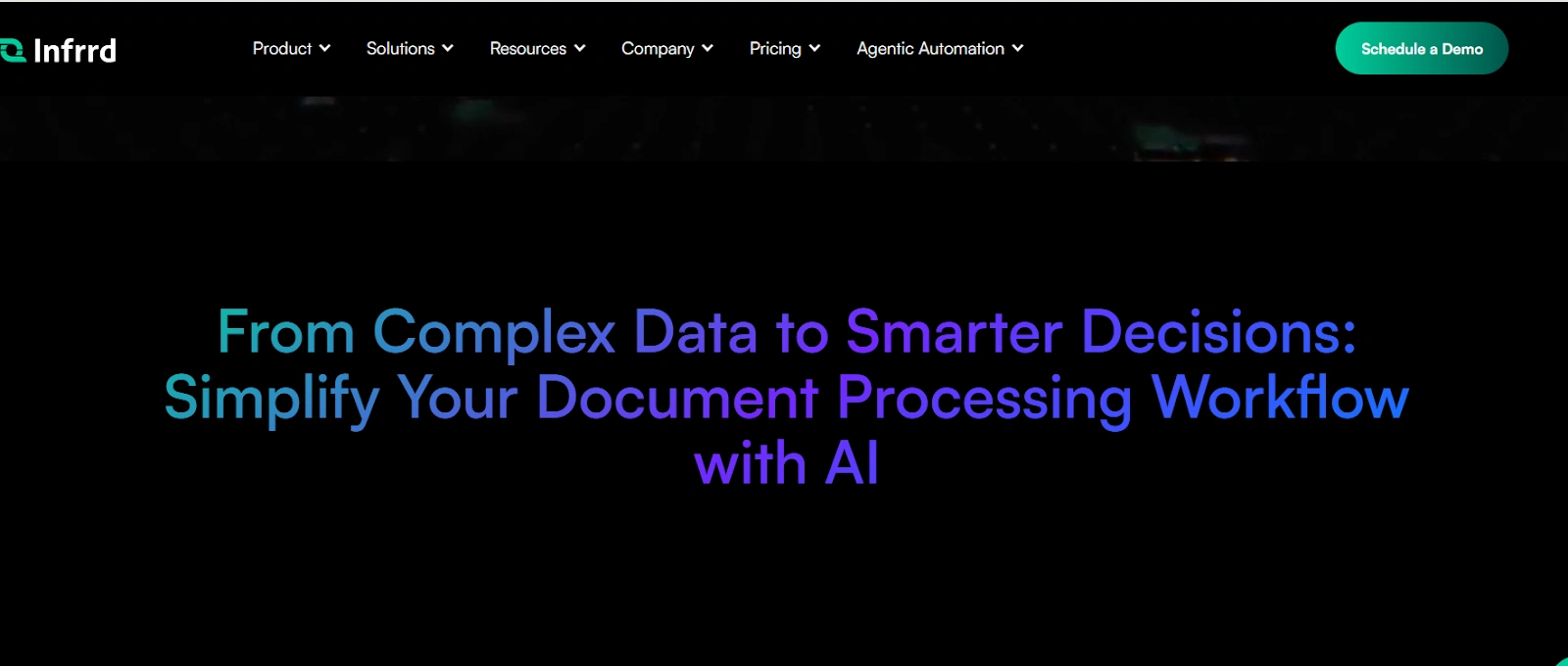
Infrrd is an AI-powered IDP platform often ranked among the best data extraction software for regulated industries like mortgage, insurance, finance, and engineering. It offers No-Touch Processing (NTP) to automate most tasks, Human-in-the-Loop validation for exceptions, and cross-document checks for compliance-heavy workflows.
Features
- Template-free, AI-driven extraction
- Handles structured, semi-structured, and unstructured documents
- SLA-based exception handling
- Human-in-the-loop validation with maker-checker
- Seamless ERP and LOS integrations (SAP, Oracle, NetSuite)
- No-Touch Processing (NTP) + Agentic AI
Pros
- Flexible, no templates required
- Accurate with complex layouts and tables
- SLA awareness for compliance-heavy workflows
- Cross-document validation across loan/claims files
Cons
- Best for mid-to-large enterprises
- May be too advanced for small teams
Pricing
- Standard IDP packages
- NTP for minimal human intervention
- AGP (Accuracy Guarantee Policy) with human+AI
- Custom enterprise deployments
- Pricing is based on volume, complexity, and AI needs
Best For: Regulated industries (mortgage, insurance, finance, engineering).
Curious how Infrrd stacks up directly against Rossum?
Check out our detailed Infrrd vs. Rossum comparison guide for side-by-side insights.
2. Rossum
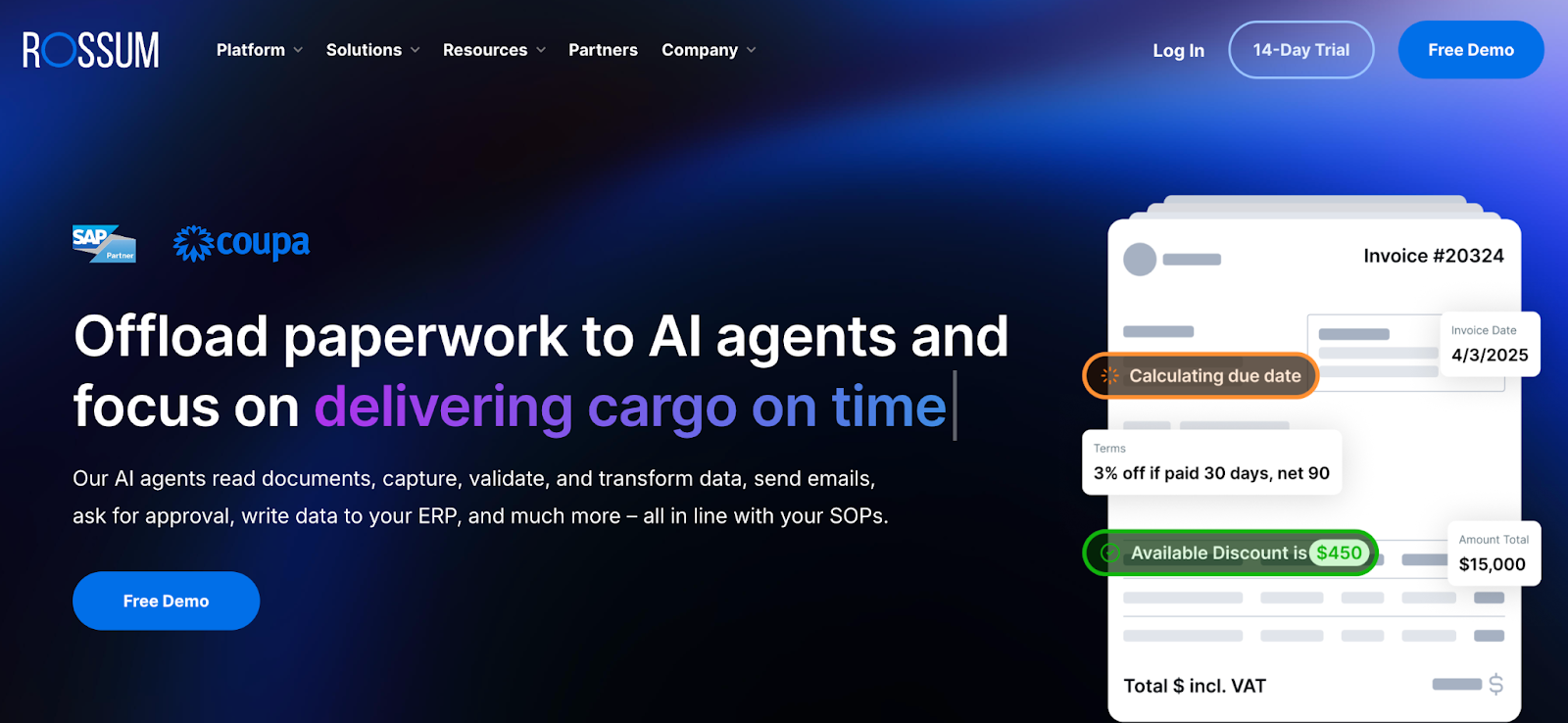
Rossum is often included in discussions of the best data extraction software for finance teams. It uses adaptive machine learning to process invoices and receipts without relying on rigid templates, making it ideal for accounts payable and compliance teams.
Features
- AI-first invoice and receipt extraction
- Adaptive machine learning models
- Built-in compliance checks and audit trails
- API and workflow automation capabilities
- Cloud-native deployment for finance teams
Pros
- Learns new document formats quickly
- Reduces reliance on rigid templates
- Strong invoice and AP automation
- Simple cloud setup
Cons
- Primarily focused on finance and accounting
- Limited coverage outside AP use cases
Pricing
- Enterprise subscription model
CTA:
See how much ROI you can achieve with automation
Calculate your savings here.
3. Abbyy FlexiCapture

Abbyy FlexiCapture is a long-standing enterprise-grade platform and is frequently cited as one of the best data extraction software solutions for global organizations. Its OCR engine is highly accurate and supports more than 200 languages.
Features
- Enterprise-grade OCR engine
- Supports 200+ languages
- Handwriting recognition available
- Document classification and field-level extraction
- SDK and API for custom integrations
Pros
- Mature and reliable OCR
- Multilingual capability for global operations
- Strong compliance adoption in regulated industries
Cons
- Steeper learning curve during setup
- Expensive for SMBs
Pricing
- Enterprise licensing with tiered pricing
- Based on seats, processing volume, and deployment model
4. UiPath Document Understanding
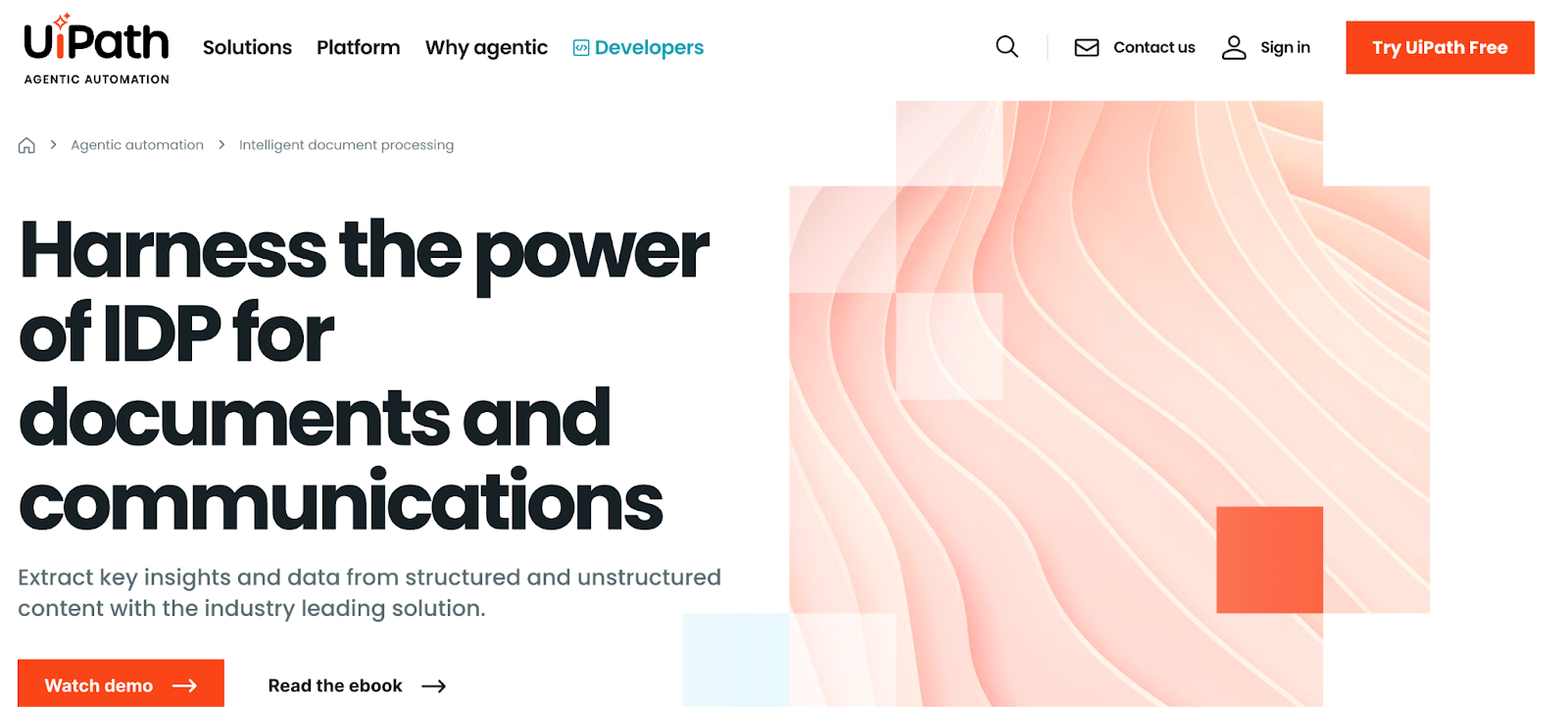
UiPath Document Understanding combines OCR and machine learning with its RPA platform, placing it on many lists of the best data extraction software for enterprises seeking full workflow automation.
Features
- Combines OCR and ML with RPA workflows
- Built-in AI Center for training models
- Confidence scoring for extracted fields
- Maker-checker validation options
- Cloud and on-prem deployment flexibility
Pros
- Strong enterprise RPA integration
- Handles end-to-end workflows
- Scales well across industries
Cons
- Technical setup required
- Better suited for organizations already invested in UiPath
Pricing
- Custom enterprise pricing
- Bundled with UiPath automation licenses
Modern extraction is about more than text capture. See how platforms go beyond OCR.
5. Docparser
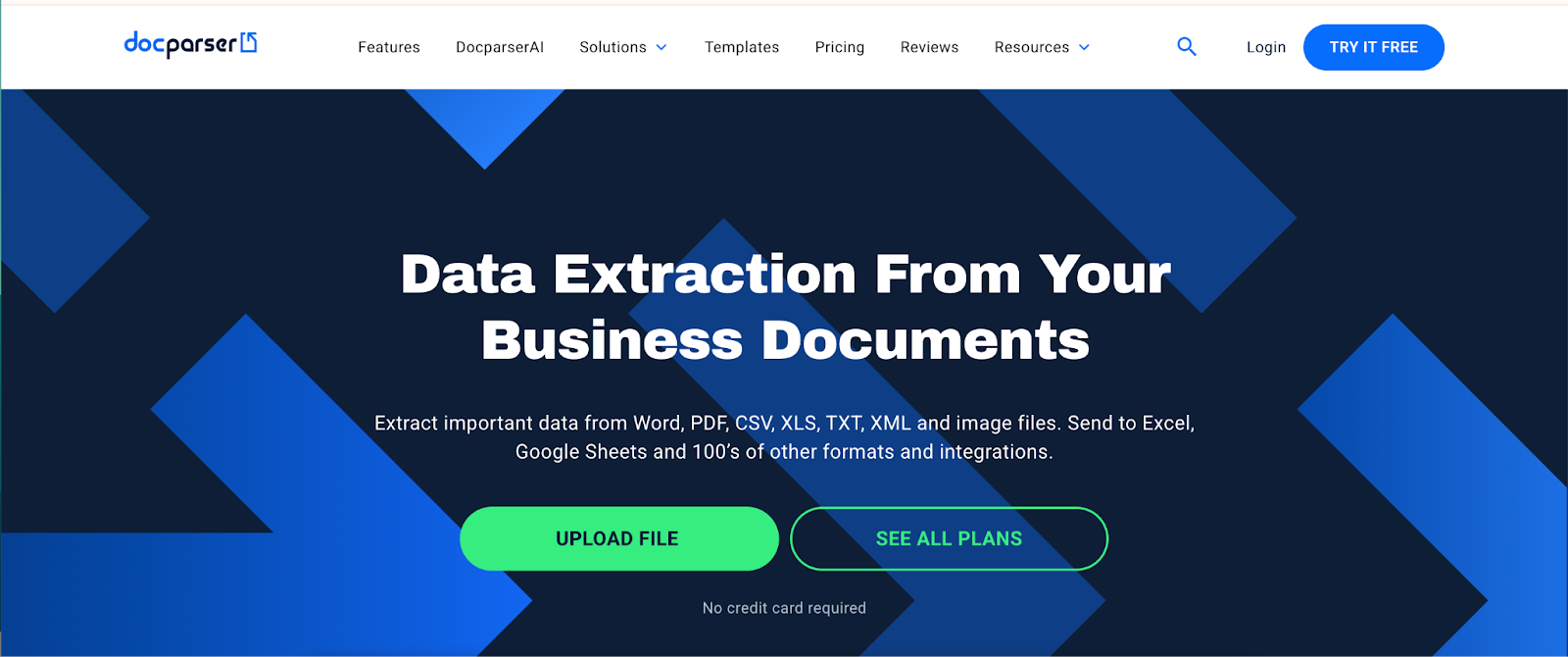
Docparser is one of the best data extraction software options for SMBs. It focuses on parsing PDFs and exporting structured data into Sheets, Excel, and CRMs, making it a popular lightweight choice.
Features
- PDF parsing templates
- Exports to Excel, Google Sheets, and CRMs
- Cloud-based processing
- Batch document support
- Integrates with Zapier for automation
Pros
- Affordable for SMBs
- Easy to configure without coding
- Works well for recurring PDF tasks
Cons
- Limited scalability for enterprises
- Minimal compliance features
Pricing
- Starts at $32.50/month
- Plans scale with document volume and integrations
6. Import.io

Import.io specializes in web data extraction, making it one of the best data extraction software tools for e-commerce companies and market researchers. It can convert websites into structured datasets at scale.
Features
- Web scraping at scale
- Real-time APIs for data delivery
- Point-and-click extraction setup
- Supports large datasets for analytics
- Integration with BI tools
Pros
- Great for market research and e-commerce pricing
- Scales to millions of rows of web data
- API-friendly
Cons
- No offline document support
- Focused only on web-based data
Pricing
- Custom quotes based on usage and datasets
7. Octoparse
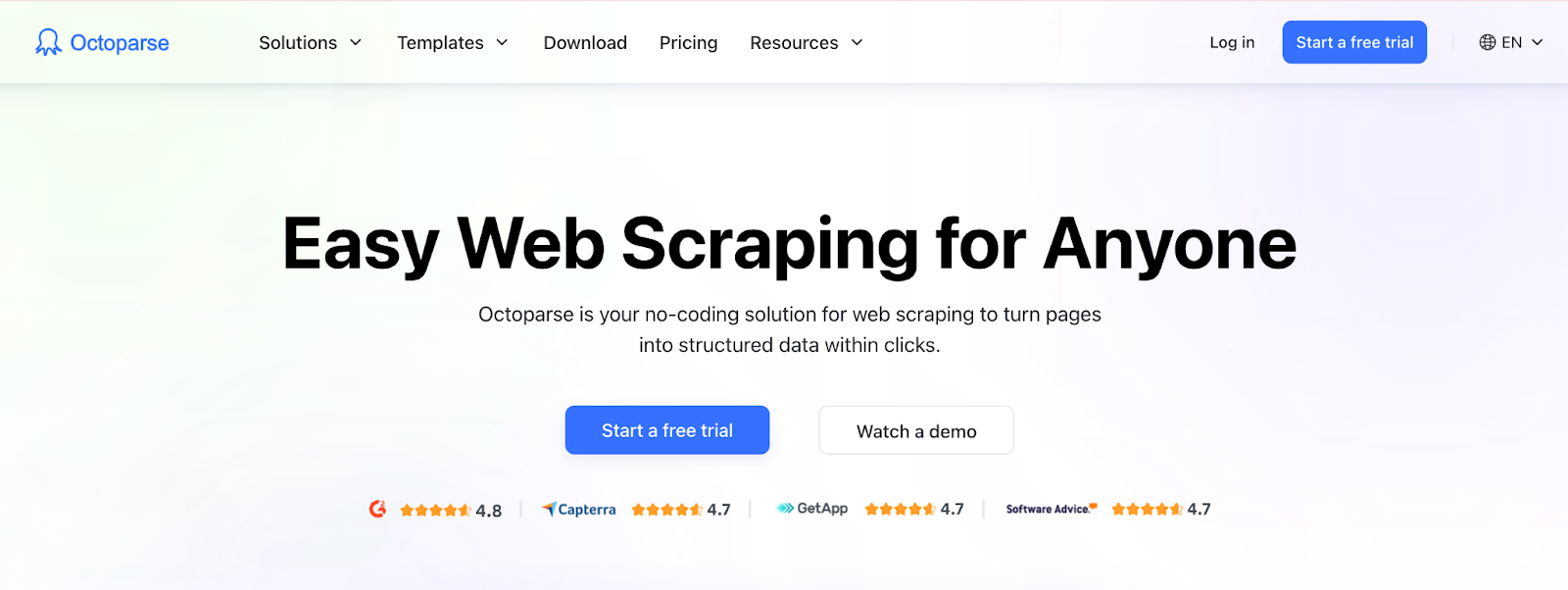
Octoparse is a no-code web scraping tool that earns its place among the best data extraction software for business users who want to collect online data quickly. Its pre-built templates make setup simple.
Features
- No-code web scraping with visual workflow builder
- Pre-built templates for common websites
- Cloud-based scraping with scheduling
- Data export to Excel, CSV, and APIs
Pros
- Beginner-friendly
- Easy scheduling and automation
- Affordable entry-level option\
Cons
- Web-only, no document handling
- Limited for highly complex sites
Pricing
- Free plan available
- Paid plans start at $89/month
8. ParseHub

ParseHub is built for dynamic websites, including JavaScript-heavy content. It is widely recognized as one of the best data extraction software platforms for advanced web scraping projects.
Features
- Dynamic site scraping with AJAX and JavaScript support
- Both desktop and cloud extraction
- Scheduling and API data delivery
- Visual project builder
Pros
- Works with complex, dynamic sites
- Flexible for different scraping needs
- No coding required
Cons
- Steeper learning curve than Octoparse
- Web-only focus
Pricing
- Free plan
- Paid plans start at $189/month
9. Tabula (Open Source)
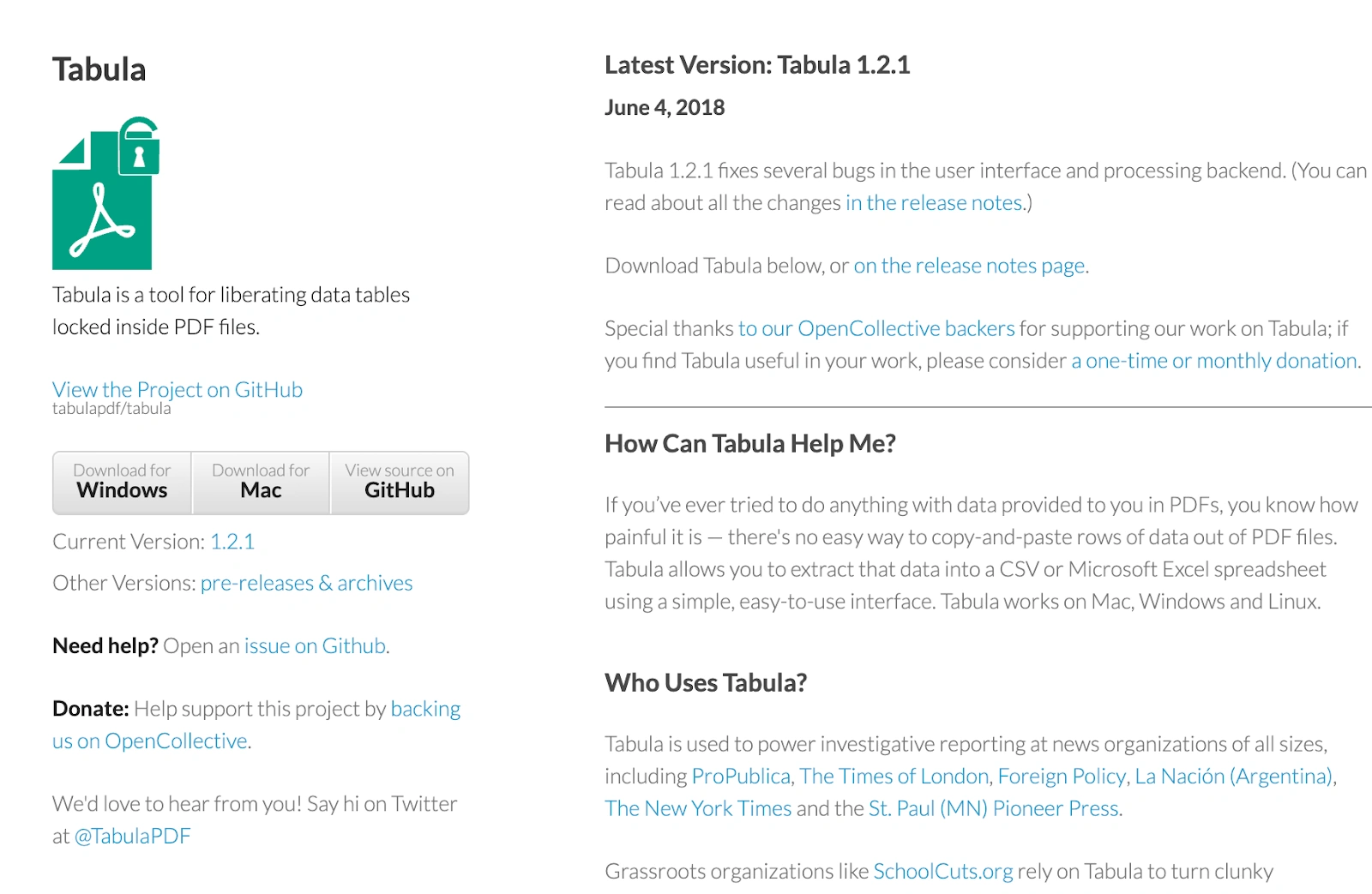
Tabula is an open-source tool for extracting tables from PDFs. While limited, it remains one of the best data extraction software options for users who need a simple, free way to extract tabular data.
Features
- Extracts tables from PDFs
- Exports to CSV or Excel
- Open-source and free
- Lightweight desktop tool
Pros
- Completely free
- Simple and effective for tables
- Widely used by researchers and journalists
Cons
- No OCR for scanned documents
- Limited to structured table extraction
Pricing
- Free, open-source software
Comparison Matrix
Here’s how the best data extraction software platforms compare:
FAQs About Best Data Extraction Software
1. What’s the difference between data extraction, ETL, OCR, and web scraping?
Data extraction pulls information from documents. ETL moves structured data between databases and SaaS apps. OCR reads printed or scanned text. Web scraping collects data from websites.
2. Which tool type should I use for scanned PDFs vs. digital forms?
For scanned PDFs, use platforms with strong OCR and AI models like Infrrd,. For digital forms, lighter tools such as Docparser are enough.
3. How to validate extracted data without slowing teams down?
Choose software with maker-checker workflows and confidence scoring. Reviewers only check low-confidence fields, keeping speed high without losing accuracy.
4. What accuracy should I expect on invoices, IDs, or loan docs?
Invoices and IDs reach 90–95% accuracy. Complex loan files need cross-document validation to achieve reliable levels.
5. Can I automate cross-document checks (e.g., W-2 vs. 1003 vs. VOE)?
Yes. Advanced platforms support automated validation across multiple documents to confirm income, employment, or loan amounts.
In a Nutshell
The right data extraction software is not about flashy features. It’s about measurable outcomes: fewer errors, faster turnaround, and workflows that hold up under regulatory pressure.
If you manage mortgages, insurance claims, invoices, or engineering drawings, the choice of platform should come down to accuracy, validation options, integration depth, and cost of ownership. Some tools shine in web scraping, others in parsing PDFs, and a few, like Infrrd, stand out for handling regulated, document-heavy work at scale.
The next step is simple: define your document mix, run a pilot with real files, and compare results against your accuracy and throughput benchmarks.
The results and ROI will point you to the right data extraction software.
FAQs
Using AI for pre-fund QC audits offers the advantage of quickly verifying that loans meet all regulatory and internal guidelines without any errors. AI enhances accuracy, reduces the risk of errors or fraud, reduces the audit time by half, and streamlines the review process, ensuring compliance before disbursing funds.
Choose software that offers advanced automation technology for efficient audits, strong compliance features, customizable audit trails, and real-time reporting. Ensure it integrates well with your existing systems and offers scalability, reliable customer support, and positive user reviews.
Audit Quality Control (QC) is crucial for mortgage companies to ensure regulatory compliance, reduce risks, and maintain investor confidence. It helps identify and correct errors, fraud, or discrepancies, preventing legal issues and defaults. QC also boosts operational efficiency by uncovering inefficiencies and enhancing overall loan quality.
Mortgage review/audit QC software is a collective term for tools designed to automate and streamline the process of evaluating loans. It helps financial institutions assess the quality, compliance, and risk of loans by analyzing loan data, documents, and borrower information. This software ensures that loans meet regulatory standards, reduces the risk of errors, and speeds up the review process, making it more efficient and accurate.
IDP (Intelligent Document Processing) enhances audit QC by automatically extracting and analyzing data from loan files and documents, ensuring accuracy, compliance, and quality. It streamlines the review process, reduces errors, and ensures that all documentation meets regulatory standards and company policies, making audits more efficient and reliable.
Yes, AI can identify and extract changes in revised engineering drawings, tracking modifications to ensure accurate updates across all documentation.







